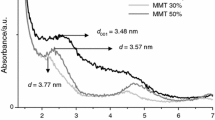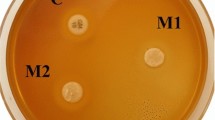Abstract
Dental composites are aesthetic materials widely used in Dentistry for replacing hard dental tissues lost due to caries or traumas. The aim of this study was to fabricate low-shrinkage dental composite charged with nanoclay fillers (montmorillonite Cloisite®—MMT) and evaluate their cytotoxicity and physicomechanical properties. Four dental composites were produced from the same organic matrix: Bis-GMA/TEGDMA (30 wt.%). The filler system was constituted of BaSi, SiO2, and MMT in the following concentrations (wt.%): 93.8/6.2/0, 89.1/5.9/5, 86.7/5.8/7.5, and 84.4/5.6/10 (E0: 0; E5: 5%; E7.5: 7.5%; E10: 10% of MMT nanoclays). The following properties were tested: in vitro cytotoxicity, flexural strength, elastic modulus, volumetric shrinkage, water sorption, water solubility, and hygroscopic expansion. Scanning electron microscopy was used to characterize composites’ topography. Data were analyzed by one-way ANOVA and Tukey’s HSD post hoc test (p < 0.05). MMT nanoclays did not affect the cytotoxicity. E5 and E7.5 groups showed a significant decrease in polymerization shrinkage while maintained the overall physicomechanical properties. The inclusion of 5 and 7.5 wt.% of MMT nanoclays allowed the fabrication of dental composites with low cytotoxicity and low polymerization shrinkage, without jeopardizing the overall behaviour of their physicomechanical properties (flexural strength, elastic modulus, water sorption, water solubility, and hygroscopic expansion). These aspects suggest that the usage of MMT nanoclays could be an effective strategy to formulate new dental composites with clinical applicability.



Similar content being viewed by others
References
Bowen RL. Properties of a silica-reinforced polymer for dental restorations. J Am Dent Assoc. 1963;66:57–64.
Reis DP, Filho JDN, Rossi AL, de Almeida NA, Portela MB, da Silva EM. Remineralizing potential of dental composites containing silanized silica-hydroxyapatite (Si-HAp) nanoporous particles charged with sodium fluoride (NaF). J Dent. 2019;90:103211.
Mucci V, Perez J, Vallo CI. Preparation and characterization of light-cured methacrylate/montmorillonite nanocomposites. Polym Int. 2011;60:247–54.
Xue J, Wang J, Feng D, Huang H, Wang M. Application of antimicrobial polymers in the development of dental resin composite. Molecules. 2020;25:4738.
Yoshinaga K, Yoshihara K, Yoshida Y. Development of new diacrylate monomers as substitutes for Bis-GMA and UDMA. Dent Mater. 2021;37:e391–8.
Jardim RN, Rocha AA, Rossi AM, de Almeida NA, Portela MB, Lopes RT, et al. Fabrication and characterization of remineralizing dental composites containing hydroxyapatite nanoparticles. J Mech Behav Biomed Mater. 2020;109:103817.
Soares CJ, Faria ESAL, Rodrigues MP, Vilela ABF, Pfeifer CS, Tantbirojn D, et al. Polymerization shrinkage stress of composite resins and resin cements—what do we need to know? Braz Oral Res. 2017;31:62.
Ferracane JL, Hilton TJ. Polymerization stress–is it clinically meaningful? Dent Mater. 2016;32:1–10.
Kaisarly D, Gezawi ME. Polymerization shrinkage assessment of dental resin composites: a literature review. Odontology. 2016;104:257–70.
Luo S, Liu F, Yu B, He J. Preparation of low shrinkage stress Bis-GMA free dental resin composites with a synthesized urethane dimethacrylate monomer. J Biomater Sci Polym Ed. 2019;30:137–49.
Schmalz G, Galler KM. Biocompatibility of biomaterials—lessons learned and considerations for the design of novel materials. Dent Mater. 2017;33:382–93.
Ferracane JL. Resin composite—state of the art. Dent Mater. 2011;27:29–38.
Jung M, Sehr K, Klimek J. Surface texture of four nanofilled and one hybrid composite after finishing. Oper Dent. 2007;32:45–52.
Senawongse P, Pongprueksa P. Surface roughness of nanofill and nanohybrid resin composites after polishing and brushing. J Esthet Restor Dent. 2007;19:265–73.
de Moraes RR, Goncalves Lde S, Lancellotti AC, Consani S, Correr-Sobrinho L, Sinhoreti MA. Nanohybrid resin composites: nanofiller loaded materials or traditional microhybrid resins? Oper Dent. 2009;34:551–7.
Ilie N, Rencz A, Hickel R. Investigations towards nano-hybrid resin-based composites. Clin Oral Investig. 2013;17:185–93.
Pontes LF, Alves EB, Alves BP, Ballester RY, Dias CG, Silva CM. Mechanical properties of nanofilled and microhybrid composites cured by different light polymerization modes. Gen Dent. 2013;61:30–3.
Rastelli AN, Jacomassi DP, Faloni AP, Queiroz TP, Rojas SS, Bernardi MI, et al. The filler content of the dental composite resins and their influence on different properties. Microsc Res Tech. 2012;75:758–65.
Ritto FP, Moreira ES, Sampaio-Filho HR, Lacerda RA, Borges MAP, Bastian FL. Physical-mechanical evaluation of a microhybrid and nanofilled composite light activated by quartz-halogen tungsten and light-emitting diode. J Compos Mater. 2019;53:981–90.
Mahmoud SH, El-Embaby AE, AbdAllah AM. Clinical performance of ormocer, nanofilled, and nanoceramic resin composites in Class I and Class II restorations: a three-year evaluation. Oper Dent. 2014;39:32–42.
Palaniappan S, Bharadwaj D, Mattar DL, Peumans M, Van Meerbeek B, Lambrechts P. Nanofilled and microhybrid composite restorations: five-year clinical wear performances. Dent Mater. 2011;27:692–700.
Alexandre M, Dubois P. Polymer-layered silicate nanocomposites: preparation, properties and uses of a new class of materials. Mater Sci Eng R Rep. 2000;28:1–63.
Li KY, Tsai CC, Lin TC, Wang YL, Lin FH, Lin CP. Fluorinated montmorillonite and 3YSZ as the inorganic fillers in fluoride-releasing and rechargeable dental composition resin. Polymers (Basel). 2020;12:223.
Yoonessi M, Toghiani H, Kingery WL, Pittman CU. Preparation, characterization, and properties of exfoliated/delaminated organically modified clay/dicyclopentadiene resin nanocomposites. Macromolecules. 2004;37:2511–8.
Munhoz T, Fredholm Y, Rivory P, Balvay S, Hartmann D, da Silva P, et al. Effect of nanoclay addition on physical, chemical, optical and biological properties of experimental dental resin composites. Dent Mater. 2017;33:271–9.
Solhi L, Atai M, Nodehi A, Imani M. A novel dentin bonding system containing poly(methacrylic acid) grafted nanoclay: synthesis, characterization and properties. Dent Mater. 2012;28:1041–50.
Li KY, Tsai CC, Fang CH, Wang YL, Lin FH, Lin CP. Fluorinated montmorillonite composite resin as a dental pit and fissure sealant. Polymers (Basel). 2019;11:223.
International Organization for Standardization ISO 10993-5. Biological evaluation of medical devices—part 5: tests for in vitro cytotoxicity. 3th edition. Geneva,: International Organization for Standardization ISO 10993-5. 2009.
Kim J, Seo BS. How to calculate sample size and why. Clin Orthop Surg. 2013;5:235–42.
Yoshii E. Cytotoxic effects of acrylates and methacrylates: relationships of monomer structures and cytotoxicity. J Biomed Mater Res. 1997;37:517–24.
Salehi S, Gwinner F, Mitchell JC, Pfeifer C, Ferracane JL. Cytotoxicity of resin composites containing bioactive glass fillers. Dent Mater. 2015;31:195–203.
Pongprueksa P, Miletic V, Janssens H, Van Landuyt KL, De Munck J, Godderis L, et al. Degree of conversion and monomer elution of CQ/amine and TPO adhesives. Dent Mater. 2014;30:695–701.
Calheiros FC, Daronch M, Rueggeberg FA, Braga RR. Influence of irradiant energy on degree of conversion, polymerization rate and shrinkage stress in an experimental resin composite system. Dent Mater. 2008;24:1164–8.
Bationo R, Rouamba A, Diarra A, Beugre-Kouassi MLA, Beugre JB, Jordana F. Cytotoxicity evaluation of dental and orthodontic light-cured composite resins. Clin Exp Dent Res. 2021;7:40–8.
Rodrigues Junior SA, Zanchi CH, Carvalho RV, Demarco FF. Flexural strength and modulus of elasticity of different types of resin-based composites. Braz Oral Res. 2007;21:16–21.
Sideridou ID, Karabela MM. Effect of the amount of 3-methacyloxypropyltrimethoxysilane coupling agent on physical properties of dental resin nanocomposites. Dent Mater. 2009;25:1315–24.
International Organization for Standardization ISO 4049. Dentistry-polymer-based restorative materials, 4th edition. Geneva: International Organization for Standardization ISO 4049. 2009.
Chivrac F, Gueguen O, Pollet E, Ahzi S, Makradi A, Averous L. Micromechanical modeling and characterization of the effective properties in starch-based nano-biocomposites. Acta Biomater. 2008;4:1707–14.
Curtis AR, Shortall AC, Marquis PM, Palin WM. Water uptake and strength characteristics of a nanofilled resin-based composite. J Dent. 2008;36:186–93.
Ruttermann S, Wandrey C, Raab WH, Janda R. Novel nano-particles as fillers for an experimental resin-based restorative material. Acta Biomater. 2008;4:1846–53.
Tian M, Gao Y, Liu Y, Liao Y, Hedin NE, Fong H. Fabrication and evaluation of Bis-GMA/TEGDMA dental resins/composites containing nano fibrillar silicate. Dent Mater. 2008;24:235–43.
Xia Y, Zhang F, Xie H, Gu N. Nanoparticle-reinforced resin-based dental composites. J Dent. 2008;36:450–5.
Gomes de Araujo-Neto V, Sebold M, Fernandesde Castro E, Feitosa VP, Giannini M. Evaluation of physico-mechanical properties and filler particles characterization of conventional, bulk-fill, and bioactive resin-based composites. J Mech Behav Biomed Mater. 2021;115:104–288.
Salahuddin N, Shehata M. Polymethylmethacrylate-montmorillonite composites: preparation, characterization and properties. Polymers (Basel). 2001;42:8379–85.
Campos LMP, Lugão AB, Vasconcelos MR, Parra DF. Polymerization shrinkage evaluation on nanoscale-layered silicates: Bis-GMA/TEGMA nanocomposites, in photo-activated polymeric matrices. J Appl Polym Sci. 2014;131:40010.
Goncalves L, Filho JD, Guimaraes JG, Poskus LT, Silva EM. Solubility, salivary sorption and degree of conversion of dimethacrylate-based polymeric matrixes. J Biomed Mater Res B Appl Biomater. 2008;85:320–5.
Santos C, Clarke RL, Braden M, Guitian F, Davy KW. Water absorption characteristics of dental composites incorporating hydroxyapatite filler. Biomaterials. 2002;23:1897–904.
Alshali RZ, Salim NA, Satterthwaite JD, Silikas N. Long-term sorption and solubility of bulk-fill and conventional resin-composites in water and artificial saliva. J Dent. 2015;43:1511–8.
da Silva EM, Almeida GS, Poskus LT, Guimaraes JG. Relationship between the degree of conversion, solubility and salivary sorption of a hybrid and a nanofilled resin composite. J Appl Oral Sci. 2008;16:161–6.
Suiter EA, Watson LE, Tantbirojn D, Lou JS, Versluis A. Effective expansion: balance between shrinkage and hygroscopic expansion. J Dent Res. 2016;95:543–9.
Ruttermann S, Kruger S, Raab WH, Janda R. Polymerization shrinkage and hygroscopic expansion of contemporary posterior resin-based filling materials–a comparative study. J Dent. 2007;35:806–13.
Acknowledgements
The authors are grateful for the contribution of Professor Fernando Luis Bastian from Federal University of Rio de Janeiro (deceased in August 2017) for his mentorship on the doctoral thesis that supported the present work.
Author information
Authors and Affiliations
Corresponding author
Ethics declarations
Conflict of interest
The authors declare that they have no conflict of interest.
Additional information
Publisher's Note
Springer Nature remains neutral with regard to jurisdictional claims in published maps and institutional affiliations.
Rights and permissions
About this article
Cite this article
Ritto, F.P., da Silva, E.M., Borges, A.L.S. et al. Fabrication and characterization of low-shrinkage dental composites containing montmorillonite nanoclay. Odontology 110, 35–43 (2022). https://doi.org/10.1007/s10266-021-00629-w
Received:
Accepted:
Published:
Issue Date:
DOI: https://doi.org/10.1007/s10266-021-00629-w




